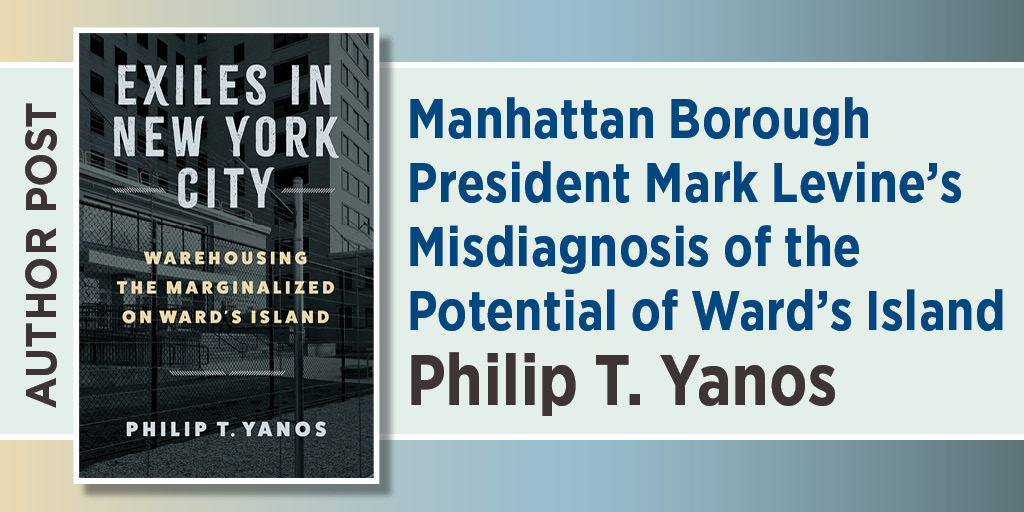Manhattan Borough President Mark Levine’s Misdiagnosis of the Potential of Ward’s Island
Philip T. Yanos

In a statement recently posted on Instagram related to his March 23 “2025 State of the Borough” address, Manhattan Borough President Mark Levine called for a recognition of Ward’s Island (which he referred to as the island’s neighbor, Randall’s Island, for reasons that are unclear) as one of Manhattan’s “hidden in plain sight” resources for addressing the borough’s persistent social problems. Specifically, he noted that Manhattan Psychiatric Center (MPC), the state hospital located on the island, has a census population of roughly 400 (its actual census is about 150 but the population approaches 400 when combined with neighboring Kirby Forensic Psychiatric Center), which is considerably below the 3,000-person population that it was built to accommodate. He asserted that MPC is an untapped resource for addressing the borough’s “mental health crisis,” and specifically recommended substantially increasing the population of MPC to house several hundred more unhoused people diagnosed with serious mental illnesses.
As discussed in my forthcoming book Exiles in New York City, it is important that the part of Ward’s Island that houses MPC’s campus be recognized as an untapped resource, but not in the way that Borough President Levine recommended. Ward’s Island currently houses roughly 1,300 socially marginalized people in seven institutions: two psychiatric hospitals, two homeless shelters, two congregate housing facilities, and a residential substance-use treatment facility (until recently it also was the location of a 2,000-person shelter for international asylum seekers). Its status as a location of institutions is nothing new and in fact dates back to the 1840s (a history that I detail in my book). Yet despite the number of people who live there, Ward’s Island has no amenities of any kind and is reachable by only a single bus (the M35) that infrequently shuttles between the island and 125th St. and Lexington Ave. in East Harlem. Life for these residents is quite isolated and difficult, as discussed in my book, with one resident stating that they are “New York’s forgotten people, discarded, not treated like people.” Any effort to expand the role of Ward’s Island to address socially marginalized people must include these individuals.
Borough President Levine’s proposal correctly recognizes that homelessness among people diagnosed with serious mental illnesses is a problem that Manhattan needs to address. However, his recommendation that in-patient state hospitalization is the solution represents a common misunderstanding of the causes of the problem. As summarized in the book (and discussed extensively by others), homelessness among people diagnosed with severe mental illnesses is largely a function of their inability to afford market-rate housing within the very restricted income offered by the US Supplemental Security Income (SSI) program (roughly $1,000 per month for an individual living alone in New York State). Psychiatric symptoms do not cause homelessness, and treating them does not lead one to find housing (I know this all too well as a public-sector mental health provider). Since it is impossible to afford market-rate housing in Manhattan (or anywhere in the United States for that matter) on this restricted income, it is essential that SSI recipients be offered housing subsidies that cover the majority of market-rate rent. The only evidence-based solution for homelessness among people diagnosed with serious mental illnesses is the Housing First approach, which offers immediate access to subsidized housing along with flexible and comprehensive supports. This approach, in addition to being clearly superior for facilitating housing stability and other outcomes (and vastly preferred by service recipients) is also much less expensive than many other approaches, especially long-term hospitalization. Not that it is cheap: between housing subsidies and services, this approach would likely cost roughly $50,000 per person per year in New York City. But this is considerably less than the roughly $1,136 per day (over $400,000 per year) that it costs to house a single person at MPC.
Despite the number of people who live there, Ward’s Island has no amenities of any kind and is reachable by only a single bus (the M35) that infrequently shuttles between the island and 125th St. and Lexington Ave. in East Harlem.
The MPC campus on Ward’s Island is indeed an untapped resource, but not because it makes sense to place more people with serious mental illness into its drab though well-staffed wards. Rather, it has adequate space to build enough new units to permanently house everyone who currently resides at the two homeless shelters on the island, as well as several hundred other low-income New Yorkers, along with space to create amenities (a grocery store, pharmacy, coffee shop, and library) that can make life on the island sustainable. I elaborate on these proposals in detail in the book, but I will note here that they wouldn’t require the closure of MPC but rather just a consolidation of its population (combined with Kirby’s) into one building to open up space for new construction.
I encourage Borough President Levine and other elected officials to consider my proposal and think of other creative ways that the untapped resource of Ward’s Island can be used to benefit the people who live there, along with the rest of New York City.
Philip T. Yanos is professor of psychology at John Jay College of Criminal Justice and the Graduate Center, City University of New York, and the author of Exiles in New York City: Warehousing the Marginalized on Ward’s Island.








